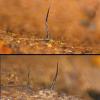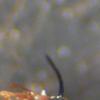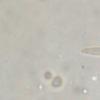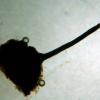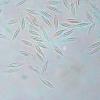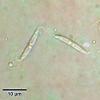
02-01-2026 17:43
MARICEL PATINOHi there, although I couldn't see the fruitbody, I

04-01-2026 17:45
 Stephen Martin Mifsud
Stephen Martin Mifsud
I was happy to find these orange asmocyetes which

03-01-2026 13:08
Niek SchrierHi all,We found groups of perithecia on a Lecanora

29-12-2025 17:44
Isabelle CharissouBonjour,J'aimerais savoir si d'autres personnes au

01-01-2026 18:35
Original loamy soil aside a artificial lake.The co

31-12-2025 19:27
Collected from loamy soil, at waterside (completel
Gnomoniaceae
Martin Bemmann,
14-02-2011 22:32
 Dear all,
Dear all,few days ago I collected some overwintered Alnus leaves with orange pustules of a conidial fungus not yet determined (any hint?). While inspecting the leaves I discovered a black fungus with long ostiole necks along the nervs. I found it very difficult to make good slides since the whole is very tiny and it is almost impossible to have a preparation without particles of the leaf that makes the slide very thick. So what I have are oblong stalked asci, 8-spored, multiseriate and with an IKI+ apical aparatus, length of the pars sporif. 29-32x7,8-8,6 µm. Didn't observe any paraphyses.
Spores are fusiforme, sometimes slightly sickle-shaped, two-celled wit some polar oildrops and some close to the septum; size 13,7-16,5 x 1,3-1,6 µm.
I do not have much literature for these genera (I do have Sogonov 2008, but the key did not work for me :-( and Stoykov 2000 for the Bulgarian Gnomoniaceae on Alnus where I found G. nervisequa similar to my collection).
Anyway, here are my pictures and I appreciate your comments!
Best regards,
Martin
(will show micros of the conidial one at wish...)
Alain GARDIENNET,
14-02-2011 22:42
Re:Gnomoniaceae
Hi Martin,
Why not Ophiognomonia ischnostyla ?
I find it regularly on this host.
Alain
Why not Ophiognomonia ischnostyla ?
I find it regularly on this host.
Alain
Martin Bemmann,
14-02-2011 22:54

Re:Gnomoniaceae
Hi Alain,
Thank you for your quick response! I considered this one too but rejected it because I did not see any appendages at the spores as demanded in the Sogonov key. I saw the spores better while focusing under the microscope as I could depict them. But I can't exclude. I must make a new slide anyway to measure the lenght of the neck, which is obviously crucial to answer the questions of this key.
Regars
Martin
Thank you for your quick response! I considered this one too but rejected it because I did not see any appendages at the spores as demanded in the Sogonov key. I saw the spores better while focusing under the microscope as I could depict them. But I can't exclude. I must make a new slide anyway to measure the lenght of the neck, which is obviously crucial to answer the questions of this key.
Regars
Martin
Martin Bemmann,
14-02-2011 23:10

Re:Gnomoniaceae
Dear Alain,
I saw your documentation of O. ischnostyla at the "base" of Ascofrance and noticed how faintly those appendages are reconizable! I really have to prepare another slide!
Best regars,
Martin
I saw your documentation of O. ischnostyla at the "base" of Ascofrance and noticed how faintly those appendages are reconizable! I really have to prepare another slide!
Best regars,
Martin
David Malloch,
15-02-2011 02:13

Re:Gnomoniaceae
Hello Martin,
Those orange spots might be telia of Melampsorium betulinum.
Dave
Those orange spots might be telia of Melampsorium betulinum.
Dave
Alain GARDIENNET,
15-02-2011 07:17
Re:Gnomoniaceae
Hi Martin,
The neck is very long in your recolt (probably around 1000 µm), and the genus Ophiognomonia is probably the best.
I believed recognize an appendage in the photo on the left, that the reason why I thought to ischnostyla. The measures of your ascospores are nearly according to it, too.
Alain
PS : Thanks to David, because I sometimes see these orange spots.
The neck is very long in your recolt (probably around 1000 µm), and the genus Ophiognomonia is probably the best.
I believed recognize an appendage in the photo on the left, that the reason why I thought to ischnostyla. The measures of your ascospores are nearly according to it, too.
Alain
PS : Thanks to David, because I sometimes see these orange spots.
Martin Bemmann,
15-02-2011 23:10
Martin Bemmann,
15-02-2011 23:16

Re:Gnomoniaceae
Hi Alain,
no time today for a proper slide, but a quick and dirty one...
I measured one neck, that was 682 µm. And here another spore (15,7 x 1, 8 µm) that does not show (to me) appendages but a slight constriction at the septum. Tomorrow I will try to make a better slide.
Best regards
Martin
no time today for a proper slide, but a quick and dirty one...
I measured one neck, that was 682 µm. And here another spore (15,7 x 1, 8 µm) that does not show (to me) appendages but a slight constriction at the septum. Tomorrow I will try to make a better slide.
Best regards
Martin
David Malloch,
16-02-2011 02:05

Re:Gnomoniaceae
Hi Martin,
That is a beautiful picture of the teleutospores of Melampsoridium sp. It's too bad you need uredinia to identify it. I suppose you could watch for then next summer.
Oh dear! I think we're discussing a basidiomycete. Can Zygomycetes be far behind?
Dave
That is a beautiful picture of the teleutospores of Melampsoridium sp. It's too bad you need uredinia to identify it. I suppose you could watch for then next summer.
Oh dear! I think we're discussing a basidiomycete. Can Zygomycetes be far behind?
Dave
Alain GARDIENNET,
16-02-2011 20:37
Re:Gnomoniaceae
Martin, it can't be another species than O. ischnostyla (=G. nervisequa, cf Sogonov & al) so you will see appendages (in red congo for example).
Alain
Alain
Martin Bemmann,
16-02-2011 22:19

Re:Gnomoniaceae
Hi Alain,
you are completely right! Appendages! Some very long ones too, as in Sogonov 2008, fig. 36B.
Measured another neck, that was 718 µm. So I am happy with O. ischnostyla. Stoykov 2000 (which I quoted for nervisequa in my initial post, did see only very short appendages, his fig. 4).
@ Dave: yes I will try to find the uredinias in summer, but I don't dare to get an expert in rust... ;-)
Best regards,
Martin
you are completely right! Appendages! Some very long ones too, as in Sogonov 2008, fig. 36B.
Measured another neck, that was 718 µm. So I am happy with O. ischnostyla. Stoykov 2000 (which I quoted for nervisequa in my initial post, did see only very short appendages, his fig. 4).
@ Dave: yes I will try to find the uredinias in summer, but I don't dare to get an expert in rust... ;-)
Best regards,
Martin
Alain GARDIENNET,
16-02-2011 22:43
Re:Gnomoniaceae
Bravo !




